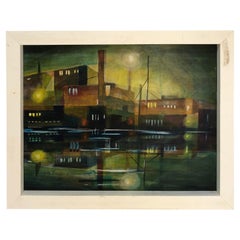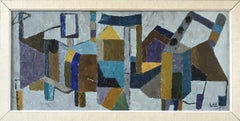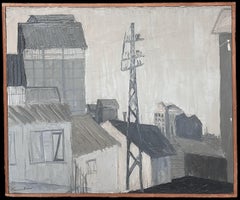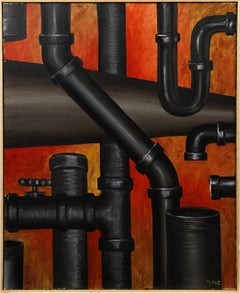Mid Century Industrial Painting
to
19
85
30
113
107
19
15
14
7
2
2
1
1
1
1
1
1
1
3
2
2
2
1
Sort By
Mid Century Cubist Painting of an Industrial Building
Located in Redding, CT
Mid Century Cubist Painting of an Industrial Building. Painting on board and housed in a solid
Category
Mid-20th Century Mid-Century Modern Paintings
Materials
Wood, Masonite
1957 Mid Century Modern Vintage Abstract Oil Painting - Industrial Abstraction
Located in Bristol, GB
mid century abstract composition in oil, painted onto canvas and dated 1957.
This painting is an
Category
Mid-20th Century Modern Abstract Paintings
Materials
Canvas, Oil
$1,080
H 13.98 in W 27.56 in
Mid 20th Century French Industrial Landscape Grey Atmospheric Oil Painting
Located in Cirencester, Gloucestershire
Francis Biard (mid 20th century)
titled verso
signed oil on canvas, framed
framed: 22 x 26.5
Category
Mid-20th Century Post-Impressionist Landscape Paintings
Materials
Oil
$1,789
H 22 in W 26.5 in
Mid Century Spring Boats in Industrial Riverside Scene French Oil Painting
Located in Cirencester, Gloucestershire
Industrial Riverside Scene
by Regine David (female French artist, 1910-2018)
oil painting on board
Category
Mid-20th Century Post-Impressionist Landscape Paintings
Materials
Oil
$474
H 10.75 in W 13.75 in
Mid Century Industrial Seascape -- Gloucester Harbor
By Charles Johnson
Located in Soquel, CA
A detailed mid century industrial seascape of Gloucester, MA Harbor scene with boats and the Old
Category
1940s Modern Paintings
Materials
Canvas, Oil
$2,000 Sale Price
20% Off
H 25 in W 29 in D 2 in
London Round House-Mid-Century Industrial American Scene Oil Painting
By Jack Steele
Located in Marco Island, FL
A mid-century American Realist scene of children playing on the railroad entitled, London Round
Category
1940s American Realist Landscape Paintings
Materials
Canvas, Oil
$14,000
H 52 in W 43 in D 3 in
Vintage Mid Century Modernist Industrial Abstract Framed Signed Oil Painting
Located in Buffalo, NY
Antique American modernist industriala oil painting. Oil on canvas. Signed. Framed.
Category
1970s Modern Landscape Paintings
Materials
Canvas, Oil
$716 Sale Price
20% Off
H 32 in W 26 in D 2 in
Mid Century Abstracted Industrial Cityscape
By Erle Loran
Located in Soquel, CA
Bold mid century abstracted landscape by Erle Loran (American, 1905-1999). Unsigned, but was
Category
Mid-20th Century Abstract Geometric Landscape Drawings and Watercolors
Materials
Paper, Pastel
$1,440 Sale Price
20% Off
H 15 in W 18 in D 0.25 in
Industrial Landscape - Huge Mid 20th Century Figurative Oil on Canvas Painting
Located in Sevenoaks, GB
Huge late 1950's oil on canvas depicting a figure in an industrial landscape by Peter Freeth RA
Category
1950s Modern Landscape Paintings
Materials
Canvas, Oil
$3,992
H 45.28 in W 36.62 in
Mid Century Pacific Grove Industrial Landscape
By Charles F. Thomas
Located in Soquel, CA
Brightly colored industrial watercolor landscape of houses and a clothesline in Pacific Grove
Category
1960s Post-Modern Landscape Paintings
Materials
Watercolor, Laid Paper
$380 Sale Price
20% Off
H 13 in W 10 in D 1 in
Mid Century Watercolor Drawing, Industrial / Architectural Theme
Located in St Annes, Lancashire
A super watercolour by an unknown artist,
C.1960
Great colours.
On artists board
Unframed.
Free shipping
Category
Vintage 1960s English Mid-Century Modern Paintings
Materials
Paper
Mid Century Nocturnal Industrial Landscape
By Joseph Yeager
Located in Soquel, CA
Detailed industrial landscape of an open-pit mine by Joseph Yeager (early-mid 20th Century) on
Category
Mid-20th Century American Impressionist Landscape Drawings and Watercolors
Materials
Paper, Watercolor
$1,200 Sale Price
20% Off
H 22 in W 30.25 in D 0.07 in
American Industrial Painting
Located in Los Angeles, CA
Large painting on cardboard.
Category
Late 20th Century American Mid-Century Modern Paintings
Materials
Wood, Cardboard
Industrial Painting with Telephone & Electric Lines
Located in Fulton, CA
Industrial style painting with an upward angle creates a dramatic view of skyscrapers, telephone
Category
Mid-20th Century American Industrial Paintings
Materials
Canvas, Wood, Paint
Boats in the Harbor - Mid Century Industrial Seascape
By Pieter Hashager
Located in Soquel, CA
Beautiful post war oil painting of boats navigating through the Bremen, Germany Industrial harbor
Category
1940s Impressionist Landscape Paintings
Materials
Masonite, Oil
$920 Sale Price
20% Off
H 22 in W 25 in D 2 in
"Industrial Cityscape, Chicago" WPA Modernism Mid-Century Cityscape 20th Century
By Aaron Bohrod
Located in New York, NY
the WPA of the 20th Century.
Aaron Bohrod (American 1907 – 1992), Industrial Cityscape, 20 x 16 inch
Category
1930s American Modern Landscape Paintings
Materials
Oil, Board
Mid Century Industrial Scene and Church Ruins Russian Cityscape
By A. Verbitski
Located in Soquel, CA
Mid 20th Century evocative Post-War (WWII) cityscape in Russia with church ruins by A. Verbitski
Category
Early 20th Century Impressionist Landscape Paintings
Materials
Linen, Oil
$1,880 Sale Price
20% Off
H 16 in W 27.5 in D 0.75 in
French Mid-Century Graphite and Pen Drawing of Annonay with Industrial Skyline
Located in Cirencester, Gloucestershire
Title: French Mid-Century Graphite and Pen Drawing of Annonay with Industrial Skyline
by Anne Marie
Category
Mid-20th Century Post-Impressionist Landscape Paintings
Materials
Pencil
$612
H 20.75 in W 17.75 in D 1 in
Daily Graphic Process - Mid 20th Century Industrial Factory Watercolor Painting
Located in Sevenoaks, GB
century)
Title: Daily Graphic Process
Medium: Watercolor on paper
Painting size: 11.5 x 14.5 inches
Mount
Category
1950s Interior Drawings and Watercolors
Materials
Watercolor
Futurist Vision - Mid-Century New York Skyline - Industrial Progress
Located in Miami, FL
Rarely do you come across a work of art that is vastly different than just about anything you see. This work is undeniably brilliant and a sheer pleasure to behold. Alexander Leydenf...
Category
1950s Art Deco Landscape Paintings
Materials
Gouache, Board, Graphite, Charcoal
$50,000
H 25.5 in W 30.5 in
Lloyd Lozes Goff Industrial Landscape Painting, American 20th Century
Located in San Francisco, CA
Lloyd Lozes Goff painting of a rural industrial landscape in gilt wood frame.
Signed oil on board
Category
Mid-20th Century American Paintings
Materials
Paint
$2,750
H 9.75 in W 12 in D 1.25 in
Mid-Century French Ink Drawing of Barges Moored on River With Industrial Bridge
Located in Cirencester, Gloucestershire
Title: Mid-Century French Ink Drawing of Barges Moored on River With Industrial Bridge
by Anne
Category
Mid-20th Century Post-Impressionist Landscape Paintings
Materials
Pen
$653
H 12 in W 19.25 in D 1 in
Industrial Railroad WPA Mid 20th Century American Scene Rural Modern Realism
By Louis Bosa
Located in New York, NY
Industrial Railroad WPA Mid 20th Century American Scene Rural Modern Realism
Large oil on canvas
Category
1940s American Realist Figurative Paintings
Materials
Canvas, Oil
$11,500
H 29 in W 35 in D 3 in
Mid Century Oakland Industrial Landscape Watercolor
Located in Soquel, CA
Mid-century Bay Area urban landscape watercolor of an industrial neighborhood in Oakland by
Category
1960s Modern Landscape Drawings and Watercolors
Materials
Paper, Watercolor
$495
H 15 in W 17.75 in D 0.13 in
NYC Subway Mid 20th Century American Modernism WPA Realism industrial Colorful
Located in New York, NY
NYC Subway Mid 20th Century American Modernism WPA Realism industrial Colorful
"New York Subway
Category
1940s American Modern Figurative Paintings
Materials
Masonite, Oil
$38,000
H 47 in W 59 in D 3 in
American Scene Industrial Modern Lamp Magazine Illustration Mid-Century c. 1930s
By Antonio Petruccelli
Located in New York, NY
American Scene Industrial Modern Lamp Magazine Illustration Mid-Century
Antonio Petruccelli (1907
Category
1930s American Modern Landscape Paintings
Materials
Gouache, Board
Boys Swimming Industrial Landscape WPA Mid 20th Century Social Realism Modernism
By Henry Ernst Schnakenberg
Located in New York, NY
Boys Swimming Industrial Landscape WPA Mid 20th Century Social Realism Modernism
Henry
Category
1940s American Modern Figurative Paintings
Materials
Canvas, Oil
1940s Painting by Colorado Artist Herndon Davis of Industrial Interior
By Herndon Davis
Located in Topeka, KS
Incredible 1940s painting by Colorado artist Herndon Davis depicting an industrial interior and
Category
Mid-20th Century American Industrial Paintings
Materials
Wood, Paint
$6,995
H 18.25 in W 22.25 in D 0.75 in
Industrial Mid-20th Century WPA Modern Men Working American Scene Social Realism
Located in New York, NY
Industrial Mid-20th Century WPA Modern Men Working American Scene Social Realism
George Pearse
Category
1910s American Modern Interior Paintings
Materials
Canvas, Oil
WPA styled Cubist Industrial Oil Painting by Joan Hedman
By WPA
Located in Cincinnati, OH
A cubist industrial WPA styled oil painting depicting a storage tank compound in the 1930's-40's
Category
Mid-20th Century American Mid-Century Modern Paintings
Materials
Canvas, Wood, Paint
Mid Century Modern East Bay Abstracted Industrial Landscape
By Erle Loran
Located in Soquel, CA
Dynamic abstracted geometric landscape drawing of the industrial East Bay California landscape by
Category
1940s Abstract Geometric Landscape Drawings and Watercolors
Materials
Charcoal, Laid Paper
$1,160 Sale Price
20% Off
H 11.75 in W 18 in D 0.1 in
"Streetscape" American Scene WPA Social Realism Mid 20th Century Industrial
Located in New York, NY
"Streetscape" American Scene WPA Era Social Realism Mid 20th Century Industrial
Herbert Heyel
Category
1930s American Realist Landscape Drawings and Watercolors
Materials
Paper, Watercolor
WPA Style Industrial Landscape Oil on Board, Signed By Artist
Located in Atlanta, GA
Industrial Landscape in WPA Style by Isaacson, Mid-20th Century. Oil on Board, Measures: 35.5" w x
Category
Mid-20th Century American Industrial Paintings
Materials
Paint
Construction Scene Industrial Cityscape
Located in Wilton Manors, FL
age. At 15 years old he turned professional by painting murals for a large department store in his
Category
Mid-20th Century Cubist Landscape Paintings
Materials
Watercolor
$900 Sale Price
55% Off
H 21 in W 19 in D 1 in
A Serene Cubist Industrial Site
Located in San Francisco, CA
Only an artist (or a stockholder) could see the beauty in a cobbled-together industrial complex
Category
Mid-20th Century Cubist Landscape Paintings
Materials
Masonite, Oil
"Cubist Factory" American Scene WPA Social Realism Mid 20th Century Industrial
Located in New York, NY
"Cubist Factory" American Scene WPA Era Social Realism Mid 20th Century Industrial
Herbert Heyel
Category
1930s American Realist Landscape Drawings and Watercolors
Materials
Paper, Watercolor
"Rail Yard" Urban Industrial WPA American Scene Drawing NYC Mid-Century
By Joseph Solman
Located in New York, NY
"Rail Yard" Urban Industrial WPA American Scene Drawing NYC Mid-Century. Initialed "JS" upper right
Category
1930s American Modern Landscape Drawings and Watercolors
Materials
Paper, Gouache
$5,500
H 17 in W 15 in D 2 in
Brattleboro Vermont VT Industrial Landscape
Located in Wilton Manors, FL
interest in art at an early age. At 15 years old he turned professional by painting murals for a large
Category
Mid-20th Century Cubist Landscape Paintings
Materials
Watercolor
$900 Sale Price
55% Off
H 18 in W 22 in
Bridge Painter WPA American Modernism Mid 20th-Century Realism Industrial Worker
By Louis Wolchonok
Located in New York, NY
Bridge Painter WPA American Modernism Mid 20th-Century Realism Industrial Worker. Sight size: 18 x
Category
1930s American Realist Figurative Drawings and Watercolors
Materials
Paper, Watercolor
Railroad Worker Industrial WPA American Scene Mid Century Modern Social Realism
By Jo Cain
Located in New York, NY
Railroad Worker Industrial WPA American Scene Mid Century Modern Social Realism
Jo Cain (1904
Category
1930s American Realist Figurative Drawings and Watercolors
Materials
Paper, Oil
$5,000
H 43 in W 34 in D 2 in
Abstract Midcentury Oil Painting on Board Industrial Scene by F. David Taggart
Located in Sherborne, Dorset
A striking 1960s abstract painting, possibly of a Northern England Industrial street scene. Oil on
Category
Vintage 1960s British Mid-Century Modern Paintings
Materials
Wood, Paint
$653
H 26.78 in W 23.43 in D 3.15 in
Man Working Mid 20th Century American Scene Social Realism Industrial WPA Modern
By Jo Cain
Located in New York, NY
Man Working Mid 20th Century American Scene Social Realism Industrial WPA Modern
Jo Cain (1904
Category
1930s American Realist Figurative Drawings and Watercolors
Materials
Paper, Gouache
$5,000
H 48 in W 28 in D 2 in
Industrial Man Working Mid 20th Century American Scene Social Realism Modern WPA
By Jo Cain
Located in New York, NY
Industrial Man Working Mid 20th Century American Scene Social Realism Modern WPA
Jo Cain (1904
Category
1930s American Realist Figurative Drawings and Watercolors
Materials
Paper, Gouache
$18,000
H 44 in W 32 in D 2 in
"Steel Factory" Cuban Mid 20th Century Modern Drawing WPA Latin Art Industrial
Located in New York, NY
"Steel Factory" Cuban Mid 20th Century Modern Drawing WPA Latin Art Industrial
Ink on paper. 12 x
Category
1930s Modern Figurative Drawings and Watercolors
Materials
Paper, Ink
Machine Age Industrial WPA Era American Scene Social Realism Mid 20th Century
By Jo Cain
Located in New York, NY
Machine Age Industrial WPA Era American Scene Social Realism Mid 20th Century
Jo Cain (1904 - 2003
Category
1930s Interior Drawings and Watercolors
Materials
Gouache, Board
$8,500
H 27 in W 46 in D 2 in
Industrial Harbor Scene with Smokestacks and Factory Buildings Reflected
Located in Cirencester, Gloucestershire
Industrial Harbor Scene
Signed by Édouard Righetti (1924-2001)
dated 1961
Oil/gouache painting on
Category
Mid-20th Century Post-Impressionist Landscape Paintings
Materials
Oil, Gouache
1960’s French Modernist Large Oil Colorful Industrial Landscape Masts
By Josine Vignon
Located in Cirencester, Gloucestershire
Industrial Landscape
by Josine Vignon (French 1922-2022)
signed and stamped verso
oil painting on
Category
Mid-20th Century Post-Impressionist Landscape Paintings
Materials
Canvas, Oil
$1,927
H 36 in W 29 in D 1 in
Figure Washing in Country Stream next to Industrial Building French Signed Oil
Located in Cirencester, Gloucestershire
Figure in Landscape
French, signed and dated 1931
oil on board unframed
board: 13 x 16 inches
Provenance: private collection, France
Condition: very good condition
For more any mor...
Category
Mid-20th Century Impressionist Landscape Paintings
Materials
Oil
"Colonial Sand and Stone Company, New York, " Industrial WPA Scene, Precisionist
By William Sharp
Located in New York, NY
William Sharp (1900 - 1961)
Factory on the River
Oil on canvas
20 1/2 x 28 1/2 inches
Initialed lower left: WS
Provenance:
Estate of the artist
Private Collection, New York
Swann Au...
Category
Mid-20th Century American Realist Landscape Paintings
Materials
Canvas, Paint, Oil
"Factory on the River" Modernist and Precisionist WPA Industrial New York Scene
By William Sharp
Located in New York, NY
William Sharp (1900 - 1961)
Factory on the River
Oil on canvas
17 1/2 x 23 1/4 inches
Initialed lower right: WS
Provenance:
Estate of the artist
Private Collection, New York
Swann A...
Category
Mid-20th Century American Realist Landscape Paintings
Materials
Canvas, Paint, Oil
$5,600 Sale Price
20% Off
H 17.5 in W 23.25 in
Jack Hambleton Snowy Industrial Landscape Watercolor c.1970
Located in San Francisco, CA
Jack Hambleton (1916-1988) Snowy Industrial Landscape Watercolor c.1970
Original watercolor on
Category
Mid-20th Century Impressionist Landscape Drawings and Watercolors
Materials
Watercolor
$750
H 25.5 in W 33.5 in D 2 in
Art Professors Stool Painting Studio Workshop Shock-Absorbing Vintage Industrial
By Jean Prouvé
Located in Hyattsville, MD
Art Professor's Workshop Stool. Shock-Absorbing stool, inside it is spring loaded and sags under weight for comfort.
Category
Vintage 1950s American Mid-Century Modern Stools
Materials
Steel
$796 Sale Price
20% Off
H 36 in Dm 12 in
Industrial Rendering of an Imaginary Clock by Rene Pinchuk
By Rene Pinchuk
Located in Papaikou, HI
A beautifully precise gouache on paper done, circa late 1960s as a portfolio example. Recent framing.
Category
Vintage 1960s American Mid-Century Modern Paintings
Materials
Wood, Glass, Gouache, Paper
Edward B. Epstein: Air View of a Steel Mill, 1958, Industrial
By Edward B. Epstein
Located in Warwick, NY
Painted in the manner of precisionist Charles Sheeler, this painting presents a classic industrial
Category
Vintage 1950s American Mid-Century Modern Paintings
Materials
Wood Panel
American 1940’s WPA Surrealist Style Landscape French Female Artist Cecile Belle
Located in Atlanta, GA
An American circa 1940’s WPA / surrealist style landscape painting by French American female artist
Category
Mid-20th Century American Industrial Paintings
Materials
Canvas, Wood, Paint
$2,495
H 33.75 in W 38.75 in D 2 in
1957 Mid Century Modern Vintage Abstract Oil Painting - Industrial Abstraction
Located in Bristol, GB
mid century abstract composition in oil, painted onto canvas and dated 1957.
This painting is an
Category
Mid-20th Century Modern Abstract Paintings
Materials
Oil, Canvas
$1,080
H 13.98 in W 27.56 in
Original Painting. Fortune Mag Cover Proposal. American Mid Century Industrial
By Antonio Petruccelli
Located in New York, NY
Original Painting. Fortune Mag Cover Proposal. American Mid Century Industrial
Antonio Petruccelli
Category
1940s American Modern Landscape Paintings
Materials
Gouache, Board
Industrial WPA Mid-Century American Scene Modernism Industrial Mural Study
Located in New York, NY
Industrial WPA Mid-Century American Scene Modernism Industrial Mural Study.
A label verso titles
Category
1940s American Modern Landscape Paintings
Materials
Oil, Board
$8,500
H 30 in W 41 in D 2 in
- 1
Get Updated with New Arrivals
Save "Mid Century Industrial Painting", and we’ll notify you when there are new listings in this category.
Mid Century Industrial Painting For Sale on 1stDibs
On 1stDibs, you can find the most appropriate mid century industrial painting for your needs in our varied inventory. In our selection of items, you can find Modern examples as well as a Impressionist version. If you’re looking for a mid century industrial painting from a specific time period, our collection is diverse and broad-ranging, and you’ll find at least one that dates back to the 18th Century while another version may have been produced as recently as the 20th Century. On 1stDibs, the right mid century industrial painting is waiting for you and the choices span a range of colors that includes gray, brown, beige and black. There have been many interesting mid century industrial painting examples over the years, but those made by Joseph Yeager, Erle Loran, A. Verbitski, Robert Addison and Aaron Bohrod are often thought to be among the most thought-provoking. These artworks were handmade with extraordinary care, with artists most often working in paint, oil paint and paper.
How Much is a Mid Century Industrial Painting?
A mid century industrial painting can differ in price owing to various characteristics — the average selling price for items in our inventory is $2,670, while the lowest priced sells for $395 and the highest can go for as much as $44,000.
Questions About Mid Century Industrial Painting
- 1stDibs ExpertOctober 12, 2021There are many colors available for painting a mid-century modern home and it is a matter of preference. You can choose from a range of colors that are closely associated with mid-century modernism — popular pairings include orange and brown or chartreuse and gray, for example. Find a wide variety of mid-century modern furniture, decorative pieces, serveware and lighting on 1stDibs today.
More Ways To Browse
Mid Century Cabinet Handles
Boho Mid Century Modern
Mid Century Metal Cabinet
Country Arts And Craft
Mid Century Storage Metal Cabinet
Vintage Industrial Cabinet
Industrial Metal Cabinets
Mid Century Atomic
Man Cave
Display Board
Vintage Industrial Storage Cabinets
Man Cave Furniture
Large Industrial Storage Cabinet
Furniture Kansas City
Vintage Pens
Telephone Furnitures
Vintage Industrial Metal Storage Cabinet
Vintage Industrial Furniture London








